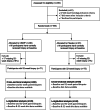Nutrition assessment and MASH severity in children using the Healthy Eating Index
- PMID: 38055641
- PMCID: PMC10984667
- DOI: 10.1097/HC9.0000000000000320
Nutrition assessment and MASH severity in children using the Healthy Eating Index
Abstract
Background: Pediatric metabolic-associated fatty liver disease (MAFLD) is a global health problem, with lifestyle modification as its major therapeutic strategy. Rigorous characterization of dietary content on MAFLD in children is lacking. We hypothesized an objectively measured healthier diet would positively modulate MAFLD.
Methods: Diet was assessed using the Nutrition Data System for Research in children enrolled from 10 tertiary clinical centers to determine the Healthy Eating Index (HEI, 0-100) and individual food components.
Results: In all, 119 children were included (13.3 ± 2.7 y), 80 (67%) male, 67 (18%) White, and 90 (76%) Hispanic, with an average body mass index Z-score of 2.2 ± 0.5. Diet was classified as low HEI < 47.94 (n = 39), mid HEI ≥ 47.94 and < 58.89 (n = 41), or high HEI ≥ 58.89 (n=39). Children with high HEI (healthier diet) had lower body weight (p = 0.005) and more favorable lipids. Mean serum triglycerides for low, mid, and high HEI were 163, 148, and 120 mg/dL, respectively; p = 0.04 mid versus high, p = 0.01 low versus high. Mean HDL was 38, 41 and 43 mg/dL; p = 0.02 low vs high. Less severe steatosis was noted with added sugar ≤ 10% of calories (p = 0.03). Higher lobular inflammation is associated with a higher percentage of calories from fat (OR (95% CI) = 0.95 (0.91-1.00), p = 0.04).
Conclusions: In children with MAFLD, high HEI is associated with lower body weight and more favorable lipids, while added sugar and fat intake has individual histologic features. Differential consumption of major dietary components may modify both metabolic risk factors and histologic liver injury, highlighting the importance of objective diet assessments in children with MAFLD.
Trial registration: ClinicalTrials.gov NCT01529268.
Copyright © 2023 The Author(s). Published by Wolters Kluwer Health, Inc. on behalf of the American Association for the Study of Liver Diseases.
Conflict of interest statement
Ajay Jain is a consultant for Mirum and Camp 4. Philip Rosenthal has research support from Abbvie, Albireo, Arrowhead, Gilead, Merck, Mirum, Takeda, and Travere. Philip Rosenthal is a consultant for Albireo, Audentes, BioMarin, Dicerna, Encoded, Gilead, MedinCell, Mirum, RNAV8, Takeda, Taysha, Travere. Jean Molleston reports Abbie, Albireo, Gilead, Shire, and the CF Foundation. Karen Murray reports to Albireo, Gilead, ICN Board of Directors. Brent Tetri reports to Akero, Arrowhead, Boehringer Ingelheim, BMS, Clinical Care Options, Durect, GSK, Glympse, Hepion, High Tide, HistoIndex, Labcorp, LG Chem, Madrigal, Merck, Sagimet, Senseion, Target RWE, and 89Bio; Stock options: HepGene, and HeptaBio; Institutional research grants: BMS, HighTide, Intercept, Inventiva, and Madrigal. Stavra Xanthakos reports to Target NASH. The remaining authors have no conflicts to report.
Figures
References
-
- Suri A, Song E, van Nispen J, Voigt M, Armstrong A, Murali V, et al. . Advances in the epidemiology, diagnosis, and management of pediatric fatty liver disease. Clin Ther. 2021;43:438–454. - PubMed
-
- Pugliese N, Plaz Torres MC, Petta S, Valenti L, Giannini EG, Aghemo A. Is there an ‘ideal’ diet for patients with NAFLD? Eur J Clin Invest. 2022;52:e13659. - PubMed
Publication types
MeSH terms
Substances
Associated data
Grants and funding
- U01 DK061731/DK/NIDDK NIH HHS/United States
- U01 DK061718/DK/NIDDK NIH HHS/United States
- UL1 TR000006/TR/NCATS NIH HHS/United States
- R01 NR019083/NR/NINR NIH HHS/United States
- UL1 TR001422/TR/NCATS NIH HHS/United States
- U01 DK061728/DK/NIDDK NIH HHS/United States
- UL1 TR000454/TR/NCATS NIH HHS/United States
- UL1 TR000448/TR/NCATS NIH HHS/United States
- U01 DK061734/DK/NIDDK NIH HHS/United States
- R01 DK125701/DK/NIDDK NIH HHS/United States
- R21 AI169487/AI/NIAID NIH HHS/United States
- UL1 TR000004/TR/NCATS NIH HHS/United States
- R01 DK131136/DK/NIDDK NIH HHS/United States
- U01 DK061737/DK/NIDDK NIH HHS/United States
- U01 DK061713/DK/NIDDK NIH HHS/United States
- U01 DK061732/DK/NIDDK NIH HHS/United States
- UL1 TR000150/TR/NCATS NIH HHS/United States
- U01 DK061730/DK/NIDDK NIH HHS/United States
- U24 DK061730/DK/NIDDK NIH HHS/United States
- U01 DK061738/DK/NIDDK NIH HHS/United States
- UL1 TR000424/TR/NCATS NIH HHS/United States
- ImNIH/Intramural NIH HHS/United States
- UL1 TR000040/TR/NCATS NIH HHS/United States
- UL1 TR000077/TR/NCATS NIH HHS/United States
- UL1 TR000423/TR/NCATS NIH HHS/United States
- UL1 TR000100/TR/NCATS NIH HHS/United States


